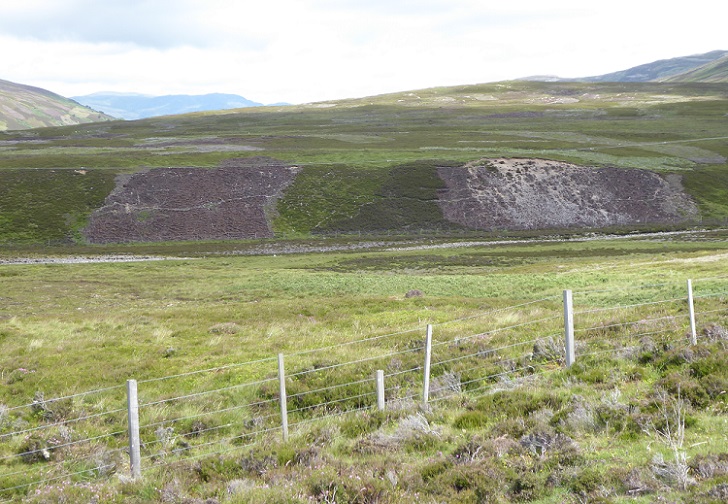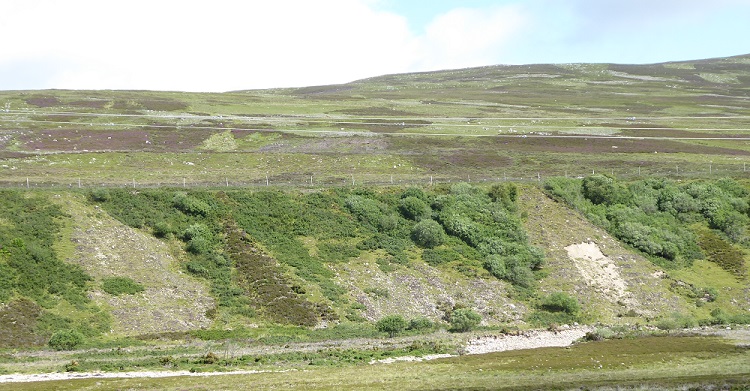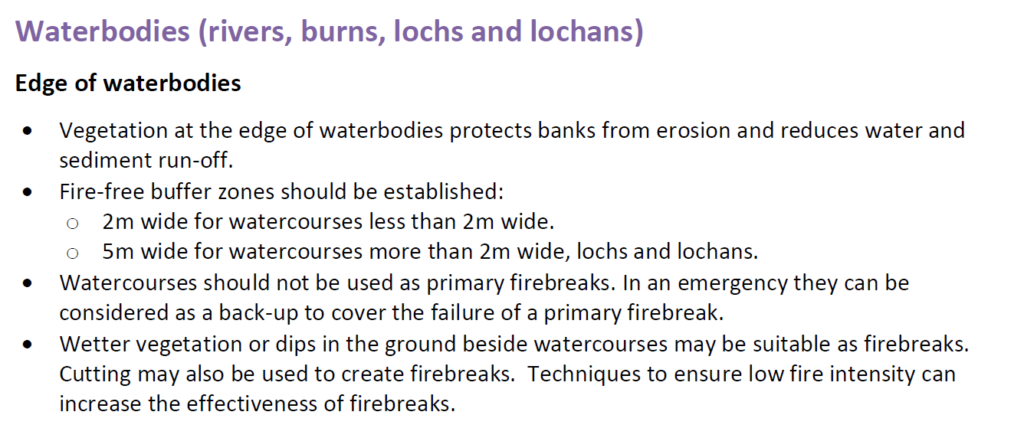
The contrast between good land management and bad land management on the western side of the Cairngorms National Park and the impact this is having on the climate and environmental crises is quite stark. I spent the last week on Speyside, collecting evidence about what is happening on the ground while out and about enjoying myself. I have already touched on Cairn Gorm (see here) and the Beauly Denny (see here) and plan a series of posts over the next few weeks based on what I saw.
In my view all muirburn is bad for the environment, releasing carbon and particulates in atmosphere, promoting water run off from hillsides and killing off wildlife to create a grouse monoculture. What I witnessed yesterday, on the banks of the Allt Cuaich, epitomised the stupidity of the practice. With global warming the incidence of intense rain events is increasing in Scotland, promoting landslips and destructive flash floods. Exposed river banks are particularly vulnerable and the best protection is a healthy covering of vegetation. Yet those responsible for muirburn on the Phones, Etteridge and Cuaich Estate have been deliberately destroying vegetation along the bank, leaving areas of exposed mineral soil just waiting to be washed away.

While heather (darker green) has in time colonised some of the ground that has been subject to burning, unless or until that happens the steep slope is even more vulnerable to water erosion and landslips (as you can see on the right of the photo). Guidance from the Scottish Environmental Protection Agency (see here) states that trees offer the best means of stabilising river banks. That guidance appears to have had absolutely no influence on the way the estate has managed the grouse moor on the north side of the Allt Cuaich.
The guidance in the Muirburn Code (see here) about burning on river banks is completely unfit for purpose given the climate and environmental emergencies:

For steep and vulnerable slopes such as those along the Allt Cuaich, it should be obvious that the whole bank should be protected. It also appears that in the case of the Allt Cuaich some of the muirburn contravenes the current guidance with some burning having started within 5 metres of the bank.
Rather, however, than trying to develop a licensing system which produces complicated rules about where muirburn can and cannot take place, it would be much simpler to ban the practice completely, starting with our National Parks. The question Mairi MacAllan, the new Minister responsible should be asking, is how come such disastrous land-management practices are continuing in the Cairngorms National Park? And how can this be allowed to take place right next to the largest and most successful conservation project in the National Park, on land owned by Anders Povslen and managed by Wildland Ltd, where muirburn has ceased and driven grouse shooting has been replaced by walked up grouse shooting?
You are right, this is witless, stupid and pointless devastation. It won’t be the big hooses which get flooded by muddy water though, will it?
Planting some trees might encourage beavers to colonise the burn as well creating fish rich and ecologically diverse pools. But there’s nae food for beavers there. A very, very great shame.
Well clearly such poor practice means that none of the estates doing this could possibly be registered as “Wildlife Estates”? It should also put any SRDP grants under question.
Its clear that the new muirburn licence system is going to have to be specific enough to stamp out this sort of environmental abuse. Its going to need a robust public consultation, backed up with evidence like this, to ensure that the licence can be enforced.
Agree entirely. Have noticed when travelling down A9 how muirburn has taken place on scree slopes triggering increased gulleying.
I have never understood why regulations were not introduced years ago both on burning in upland areas and limiting livestock access in lowland areas. We are just pouring sediment and cow crap into watercourses then wonder why they are in such poor condition. Some livestock access is required for water but in lowland areas you can see banks collapsing into watercourses and animal crap everywhere. This is really simple stuff if we are meant to be paying landowners for public goods there should be 10-20 metre wide planting belts along watercourses with a good amount of public access. Doing this will provide shade and cooler water temperatures for fish, as well as land based habitats for wildlife. There would be an element of flood resilience and such a belt would reduce all kinds of rubbish from animal crap to plastic bags getting into watercourses.
In the Alps, one of the main impacts of trees and shrubs on slopes is not that they reduce runoff but that they stabilize slopes. 60% of all forests in the Alps are solely protection forests, managed strictly under laws and practices that protect their stability and ability to withstand avalanches, landslips, and soil erosion. Looking at the shrubs in the photos from a distance, I suspect they are junipers – which endure long and replace onlyh slowly.
The silence and dithering from the Scottish Government on this issue is ‘deafening’. They have the powers to act, and even the financial powers to withdraw subsidies from offending estates, but do nothing!